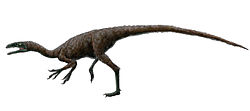- Mirischia
-
Mirischia
Temporal range: Early Cretaceous, 108 Ma
Hypothetical restoration based on related coelurosaurs Scientific classification 
Kingdom: Animalia Phylum: Chordata Class: Reptilia Superorder: Dinosauria Order: Saurischia Suborder: Theropoda Family: †Compsognathidae Genus: †Mirischia
Naish et al., 2004Species: †M. asymmetrica Binomial name Mirischia asymmetrica
Naish et al., 2004Mirischia is a small (two meter-long) extinct genus of compsognathid dinosaur from the Albian stage (Early Cretaceous period) of Brazil. Though presently known only from a pelvis and incomplete hind limbs, it preserves enough information to show that it should be recognized as a distinct species. Some phylogenetic studies incorporating this specimen have found it to be a compsognathid closely related to Compsognathus from the Upper Jurassic of Europe and Aristosuchus from the Lower Cretaceous of England[1], although it could also be a basal Tyrannosauroid[2].
Mirischia is notable for having asymmetrical ischia. Quoting from Naish et al. (2004): "The ischia of Mirischia are asymmetrical, that on the left being perforated by an oval foramen while that on the right has an open notch in the same position." The specimen is also unusual in that it originally preserved some soft tissue remains: what appears to have been an air sac was preserved between its pubic and ischial bones. Previous workers had suggested that non-avian theropods might - like birds - possess post-cranial air sacs, and Mirischia seems to confirm that.
Etymology
"Mir": from Latin mirus, 'wonderful'; "ischia": Greek, pertaining to the whole pelvis, and not the ischia alone. "asymmetrica": From its asymmetrical ischia.
References
External links
Categories:- Cretaceous dinosaurs
- Dinosaurs of South America
- Compsognathids
Wikimedia Foundation. 2010.
